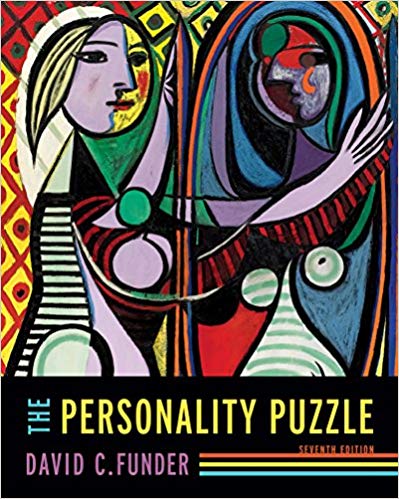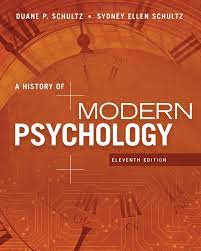Description
Test Bank for The Personality Puzzle 7th Edition By David C. Funder
Chapter 1: The Study of the Person
Part I: The Science of Personality: Methods and Assessment
Chapter 2: Personality Research Methods
Chapter 3: Assessment, Effect Size, and Ethics
Part II: How People Differ: The Trait Approach
Chapter 4: Personality Traits, Situations, and Behavior
Chapter 5: Personality Judgment
Chapter 6: Using Personality Traits to Understand Behavior
Chapter 7: Personality Stability, Development, and Change
Part III: The Mind and the Body: Biological Approaches to Personality
Chapter 8: The Anatomy and Physiology of Personality
Chapter 9: The Inheritance of Personality: Behavioral Genetics and Evolutionary Psychology
Part IV: The Hidden World of the Mind: The Psychoanalytic Approach
Chapter 10: Basics of Psychoanalysis
Chapter 11: Psychoanalysis After Freud: Neo-Freudians, Object Relations, and Current Research
Part V: Experience and Awareness: Humanistic and Cross-Cultural Psychology
Chapter 12: Experience, Existence, and the Meaning of Life: Humanistic and Positive Psychology
Chapter 13: Cultural Variation in Experience, Behavior, and Personality
Part VI: What Personality Does: Learning, Thinking, Feeling, and Knowing
Chapter 14: Learning to Be a Person: Behaviorism and the Social Learning Theories
Chapter 15: Personality Processes: Perception, Thought, Motivation, and Emotion
Chapter 16: The Self: What You Know About You
Chapter 17: Personality, Mental Health, and Physical Health
Chapter 02: Personality Research Methods
MULTIPLE CHOICE
1.The goal of the dissertation in the process of scientific education is to demonstrate that the future scientist ________.
|
a. |
has memorized all of the known facts about a given topic |
|
b. |
has read all of the known articles about a given a topic |
|
c. |
can contribute something new to the field |
|
d. |
can apply the technical knowledge learned in graduate school |
ANS:CDIF:Moderate
REF: Psychology’s Emphasis on Method: Scientific Education and Technical Training
OBJ:2.6MSC:Remembering
2.According to the text, the goal of a scientific education is ________.
|
a. |
to question what is known and how to find out what is not yet known |
|
b. |
to convey what is known about a subject so it can be applied in a medical context |
|
c. |
to train individuals to exclusively rely on deductive reasoning to solve problems |
|
d. |
all of the above |
ANS:ADIF:Easy
REF: Psychology’s Emphasis on Method: Scientific Education and Technical Training
OBJ:2.6MSC:Understanding
3.According to the text, a ________ would receive technical training, whereas a ________ would receive scientific education.
|
a. |
pharmacologist; pharmacist |
|
b. |
physician; biologist |
|
c. |
botanist; computer programmer |
|
d. |
research psychologist; clinical psychologist |
ANS:BDIF:Moderate
REF: Psychology’s Emphasis on Method: Scientific Education and Technical Training
OBJ: 2.6 MSC: Applying
4.According to the textbook, there are no perfect ________ of personality, only ________.
|
a. |
measures; devices |
c. |
theories; hypotheses |
|
b. |
indicators; clues |
d. |
reliable measures; valid measures |
ANS:BDIF:ModerateREF:Personality Data
OBJ:2.1MSC:Remembering
5.Researchers must use clues to personality in their research because________.
|
a. |
personality is defined solely by biological factors that cannot be observed |
|
b. |
personality tests are unethical |
|
c. |
personality is something hidden that resides inside an individual |
|
d. |
personality is defined by responses to self-report questionnaires |
ANS:CDIF:ModerateREF:Personality Data
OBJ:2.1MSC:Understanding
6.When gathering data or clues about personality, the best policy is to ________.
|
a. |
gather only a very small number of clues and focus on the important ones |
|
b. |
gather only clues that are certain not to be misleading |
|
c. |
rely solely on self-report data |
|
d. |
collect as many clues as possible |
ANS:DDIF:EasyREF:Personality Data
OBJ: 2.1 MSC: Applying
7.Because each kind of data has limitations, personality psychologists should ________.
|
a. |
not bother collecting data |
|
b. |
gather as much data as possible |
|
c. |
only use L data, which are the most reliable |
|
d. |
use only one source of data and control for its limitations |
ANS:BDIF:EasyREF:Personality Data
OBJ: 2.1 MSC: Applying
8.There is a possibility that individuals are so accustomed to certain aspects of their personality that they might not be aware of those traits. This is called the ________ effect.
|
a. |
fish-and-water |
c. |
self-expectancy |
|
b. |
self-verification |
d. |
narcissism |
ANS: A DIF: Moderate REF: Personality Data: Four Kinds of Clues
OBJ:2.1MSC:Remembering
9.In order to examine the relationship between early life experiences and adult criminality, Dr. Robbins asks his research participants to fill out questionnaires describing their early life. He then obtains copies of their arrest records from the county courthouse. The questionnaires used in Dr. Robbins’s study would be ________ data, whereas the arrest records would be ________ data.
|
a. |
L; B |
c. |
S; L |
|
b. |
S; I |
d. |
B; L |
ANS: C DIF: Easy REF: Personality Data: Four Kinds of Clues
OBJ:2.2MSC:Understanding
10.To assess the personality traits of a group of 5-year-olds, researchers use puppets to illustrate different personality traits. Children are then asked to pick the puppet that best matches their personality. This is an example of ________ data.
|
a. |
S |
c. |
L |
|
b. |
I |
d. |
B |
ANS: A DIF: Easy REF: Personality Data: Four Kinds of Clues
OBJ: 2.2 MSC: Applying
11.________ data are the most frequently used basis for personality assessment.
|
a. |
B |
c. |
S |
|
b. |
L |
d. |
I |
ANS: C DIF: Easy REF: Personality Data: Four Kinds of Clues
OBJ:2.3MSC:Remembering
12.I data are ________.
|
a. |
self-judgments |
|
b. |
judgments made by knowledgeable observers |
|
c. |
easily observable, real-life outcomes |
|
d. |
direct observations of the subject in some predefined context |
ANS: B DIF: Easy REF: Personality Data: Four Kinds of Clues
OBJ:2.3MSC:Remembering
13.I data essentially measure ________.
|
a. |
your internal states or emotions |
|
b. |
your level of self-awareness |
|
c. |
your reputation |
|
d. |
work productivity (in industrial psychology) |
ANS: C DIF: Moderate REF: Personality Data: Four Kinds of Clues
OBJ:2.3MSC:Remembering
14.According to the text, accidental mistakes in judging personality are considered ________, whereas inaccurate judgments that are influenced by prejudices are considered ________.
|
a. |
biases; stereotypes |
c. |
errors; biases |
|
b. |
heuristic errors; formal errors |
d. |
trivial; serious |
ANS: C DIF: Moderate REF: Personality Data: Four Kinds of Clues
OBJ:2.3MSC:Remembering
15.What is the minimum number of informants that Funder recommends for each person in a study?
|
a. |
one |
c. |
three |
|
b. |
two |
d. |
five |
ANS: B DIF: Difficult REF: Personality Data: Four Kinds of Clues
OBJ:2.3MSC:Remembering
16.According to the text, what simple example of L data is considered by clinical psychologists to be a potential indicator of psychopathology?
|
a. |
an arrest record by age 21 |
|
b. |
an annual income below the poverty line |
|
c. |
being fired from a job by age 30 |
|
d. |
never being married by age 40 |
ANS: D DIF: Difficult REF: Personality Data: Four Kinds of Clues
OBJ:2.3MSC:Remembering
17.The Thematic Apperception Test and the Rorschach test elicit ________ data.
|
a. |
L |
c. |
S |
|
b. |
I |
d. |
B |
ANS: D DIF: Moderate REF: Personality Data: Four Kinds of Clues
OBJ:2.3MSC:Remembering
18.The typical experimental social psychologist collects ________ data.
|
a. |
B |
c. |
L |
|
b. |
I |
d. |
S |
ANS: A DIF: Difficult REF: Personality Data: Four Kinds of Clues
OBJ:2.3MSC:Remembering
19.To obtain S data, a psychologist can ________.
|
a. |
develop a questionnaire |
|
b. |
recruit informants |
|
c. |
observe the subject directly |
|
d. |
look up information in public records |
ANS: A DIF: Easy REF: Personality Data: Four Kinds of Clues
OBJ:2.3MSC:Understanding
20.What you do may be influenced by how you see yourself and how you are seen by others. This means that your self-perceptions and others’ perceptions have ________.
|
a. |
definitional truth |
c. |
phenomenological force |
|
b. |
causal truth |
d. |
causal force |
ANS: D DIF: Moderate REF: Personality Data: Four Kinds of Clues
OBJ:2.3MSC:Understanding
21.What is the best way for a researcher to judge the face validity of items on a measure?
|
a. |
Conduct an exploratory factor analysis on the items. |
|
b. |
Conduct a confirmatory factor analysis on the items. |
|
c. |
Conduct an internal consistency analysis on the items. |
|
d. |
Read and consider the content of the items. |
ANS: D DIF: Moderate REF: Personality Data: Four Kinds of Clues
OBJ:2.3MSC:Understanding
22.________ data are fairly easily verifiable, concrete, real-life outcomes of possible psychological significance.
|
a. |
S |
c. |
I |
|
b. |
B |
d. |
L |
ANS: D DIF: Easy REF: Personality Data: Four Kinds of Clues
OBJ:2.3MSC:Understanding
23.________ data derive from the researcher’s direct observation of what the subject does.
|
a. |
L |
c. |
S |
|
b. |
I |
d. |
B |
ANS: D DIF: Easy REF: Personality Data: Four Kinds of Clues
OBJ:2.3MSC:Understanding
24.In a priming study, participants solved puzzles that included words such as gray, wise, retired, and Florida. After solving these puzzles, participants were observed as they walked down a hallway. The observation of participants’ speed of walking would be considered ________ data.
|
a. |
experience sampling |
c. |
L |
|
b. |
experimental B |
d. |
projective |
ANS: B DIF: Easy REF: Personality Data: Four Kinds of Clues
OBJ:2.3MSC:Understanding
25.Which kind of data would be the easiest way to obtain information about the content of dreams?
|
a. |
S |
c. |
L |
|
b. |
B |
d. |
I |
ANS: A DIF: Easy REF: Personality Data: Four Kinds of Clues
OBJ: 2.3 MSC: Applying
26.Dr. Garcia wants to measure the earliest autobiographical memories of the participants in her project. She would most likely obtain ________ data.
|
a. |
L |
c. |
S |
|
b. |
I |
d. |
B |
ANS: C DIF: Easy REF: Personality Data: Four Kinds of Clues
OBJ: 2.3 MSC: Applying





Be the first to review “Test Bank for The Personality Puzzle 7th Edition By David C. Funder”